
|
|
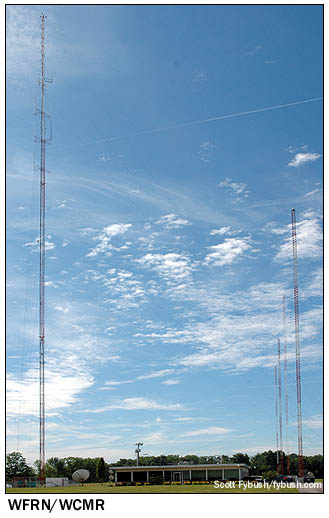 May
6, 2011
May
6, 2011
Elkhart, Indiana, 2008
It's only about two hours from our "alternate home base" of Fort Wayne, Indiana to another one of the Hoosier State's largest media markets, the twin cities of South Bend and Elkhart. And as we've been going through our photo archives to bring you the before-and-after shots of South Bend's WSBT radio/TV (seen here and here), we realized that over the last few years, we've visited most of the other broadcast facilities in town, too...yet we've never presented them here on Site of the Week.
So this week and next, we'll rectify that omission, starting at the Elkhart end of the market, 20 miles or so east of South Bend.
Elkhart's been in the news in recent years mainly for its economy, which is terrible even by northern Indiana standards: suffice it to say that the early 21st century has not been kind to a community whose economic engine was the production of mammoth, diesel-guzzling recreational vehicles.
But despite Elkhart's struggles, the city still boasts a fairly robust radio and TV scene, and we took in most of it one fine morning in June 2008.
We started out at Elkhart's religious stations, WFRN (104.7) and WCMR (1270), located in a rural area a few miles south of downtown Elkhart on County Road 26. As religious stations go, this one's an old-timer: the AM side dates back to 1956, with founder Clarence Moore's initials immortalized in its callsign. "Your Friend, WFRN" came to the FM dial in 1979, at a time when (amazingly) it was still possible for a new 50,000-watt FM station to find a home on the dial in a fairly large market.
In the years since, WFRN has become a contemporary Christian powerhouse, expanding its reach with two more full-power relays to the south and a slew of translators extending its coverage all over northern Indiana and into southern Michigan. The AM, meanwhile, ended up as a southern gospel/talk hybrid sharing the WFRN calls - at least until just a few days before our June 2008 visit, when it changed calls back to its original WCMR. (We found out about the call change when we saw the new calls displayed on the transmitters that morning!)
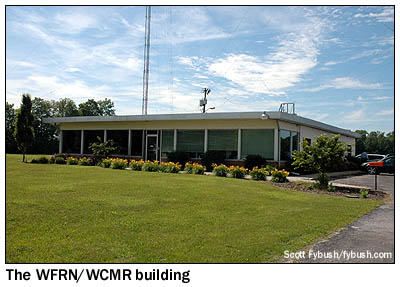
|
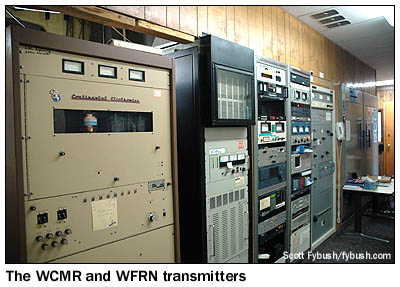
|
The facility here is simple but very workable: office space along the front, with a line of studios behind that for the AM and FM stations and production, and a line of transmitters for both the AM and the FM stations and a phasor for the AM, which runs 5000 watts by day from three towers and 1000 watts at night from all four in the array next to the station. (That's a backup Continental and a main Omnitronix for the AM and a Harris HT25 for the FM; there's also now an FM translator here, on 105.3, for the AM signal.)
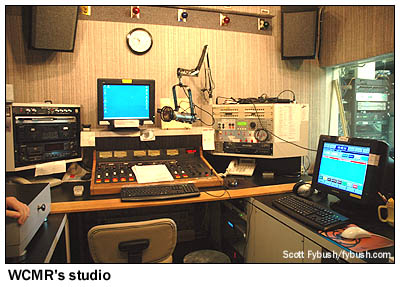
|
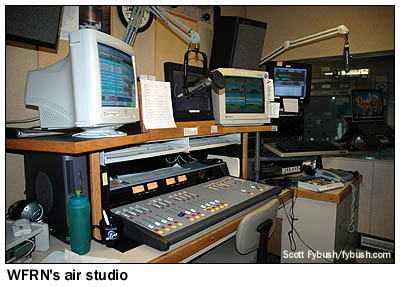
|
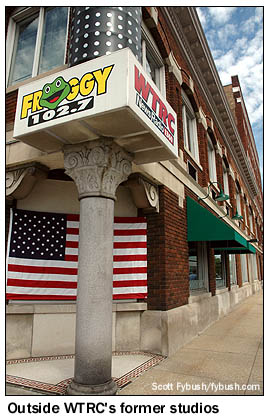
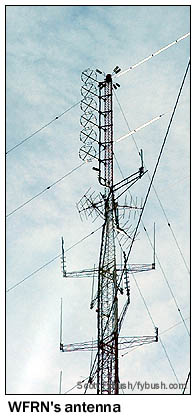 From WFRN/WCMR we
headed north into downtown Elkhart to see a set of studios that
aren't there anymore.
From WFRN/WCMR we
headed north into downtown Elkhart to see a set of studios that
aren't there anymore.
On this June day in 2008, however, Federated Media's WTRC (1340 Elkhart) and WLEG (102.7 Ligonier), were still operating from the corner of South 2nd and West Marion Streets, under the giant plastic microphone that adorned the corner of the building that's also home to the Elkhart Truth and the parent company of the stations and the newspapers, Federated Media.
WTRC was then doing Elkhart-focused news and talk, while WLEG was and is an AC station branded as "Froggy 102.7." (The callsign has a double meaning - it stands for the three big communities the station serves, Ligonier-Elkhart-Goshen, and it's a play on "frog's leg," too!)
While the studios were visible from the street corner (at least when that big flag wasn't covering the main WTRC studio window), the access was actually from down the block at the main Truth entrance, then through a warren of offices that led to the studios - WTRC right on the corner, WLEG tucked away inside.
By 2010, WTRC had gone through something of a format flip, retaining its news-talk programming but losing its Elkhart focus as it moved to Federated's "Planet Radio" hub down the road in the South Bend suburb of Mishawaka. And by then, it had become an AM adjunct to WTRC-FM 95.3, licensed to nearby Niles, Michigan, the South Bend end of what had become "95.3 MNC, Michiana's News Channel." We'll visit Planet Radio and track that end of the story in next week's installment. Meanwhile, WLEG has moved to new studios in Goshen, which we haven't seen yet. (Perhaps this summer...)
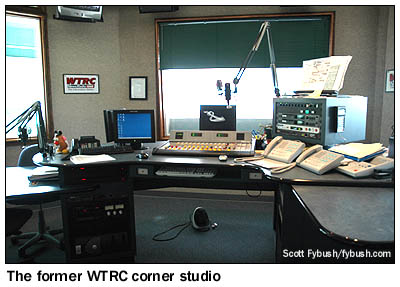
|
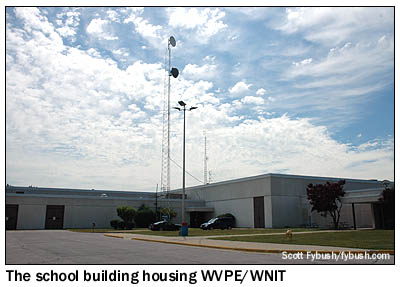
|
After our visit to WTRC, WLEG and the Truth, we head out to the northwest side of Elkhart, where the local school system operates the Elkhart Area Career Center, which was also home at the time of our visit to two public broadcasters: schools-owned WVPE (88.1 Elkhart) and the region's PBS outlet, WNIT (Channel 34/digital 35). We were eager to get a peek at WNIT's operation here because it was already on the way out by the summer of 2008: as you know if you've been following our South Bend segments, Schurz Communications' WSBT donated its former home in downtown South Bend to WNIT, and by mid-2010 the public TV station had vacated its space here in Elkhart in favor of a new state-of-the-art facility in the old WSBT space.
(WNIT had been through quite a lot of adventures on its way there: its administrative offices in a set of mobile buildings next to the career center were destroyed in a fire in early 2009, forcing the offices to move to temporary space in downtown Elkhart until the South Bend building was ready; meanwhile, its analog transmitter failed in early 2008, making WNIT one of the first full-power TV stations to go digital-only, a year ahead of the official transition.)
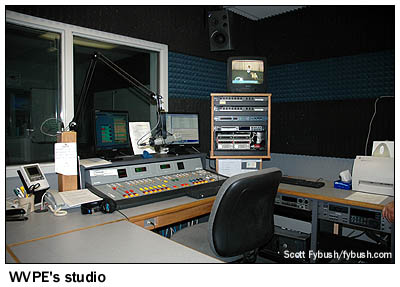
|
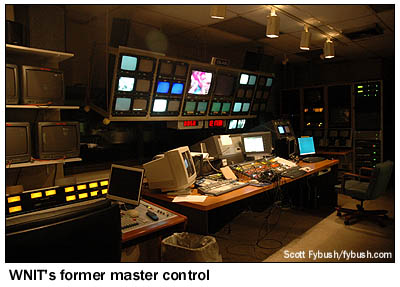
|
WVPE is still in the building, occupying a small suite of offices and studios on the second floor, down the hall from the space where WNIT's master control used to be. (Its transmitter, and WNIT's as well, are in the tower farm south of South Bend, and we'll see that as well in next week's installment.)
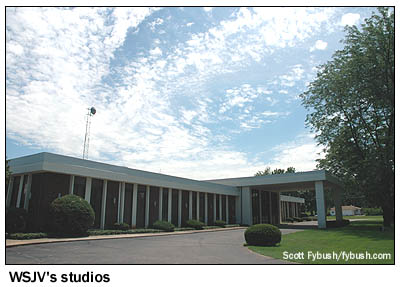
|
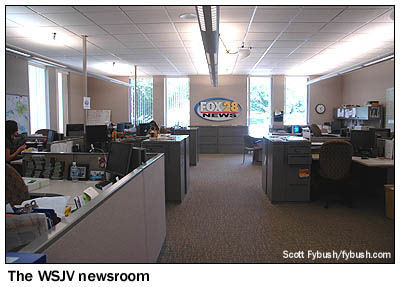
|
Our final stop in Elkhart is the only commercial TV station licensed here. After signing on in 1954 on channel 52, WSJV soon moved to channel 28, where it spent much of its life as an ABC affiliate, owned (alongside WTRC) by the Elkhart Truth.
It's been out here at its current studio home on County Road 7 south of Elkhart since at least the late 1970s, and it's been through plenty of changes in the years since. The newspaper sold the TV station to Quincy Newspapers in 1974, and in 1995 it dropped ABC in favor of Fox, which had been seen only on an LPTV in the South Bend market. (That LPTV on channel 58 is where ABC ended up; today it's WBND-LP 57, part of a Weigel Broadcasting-owned cluster that also includes low-power CW and My Network stations.)
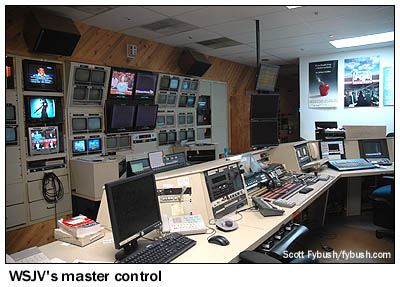
|
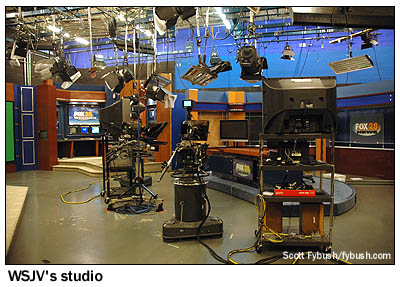
|
WSJV has done pretty well for itself since taking the Fox affiliation, producing an hour of news each night at 10 and a four-hour morning show from its compact studio/office facility here: news on one side of the building, studios and control rooms in the middle, sales at the far end. WSJV's transmitter (now on digital RF 28 after a few transitional years on RF 58) is also at the tower farm south of South Bend, and we'll see that one, too, in our next installment as we head westward to South Bend.
 - Find out when the new Tower Site is posted,
and much more! Follow us on Twitter @NERadioWatch - and don't miss your chance to order the all-new
Tower Site Calendar 2011, now on CLEARANCE at the Fybush.com store!
- Find out when the new Tower Site is posted,
and much more! Follow us on Twitter @NERadioWatch - and don't miss your chance to order the all-new
Tower Site Calendar 2011, now on CLEARANCE at the Fybush.com store!- Previous Site of the Week: Birmingham, AL, 2002
- Next Week: More South Bend
- Site of the Week INDEX!
- How can you help support Site of the Week? Click here!
- Submit your suggestions for a future Site of the Week!

